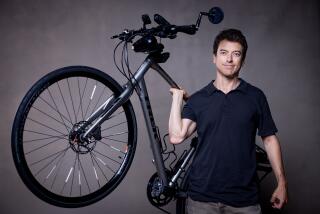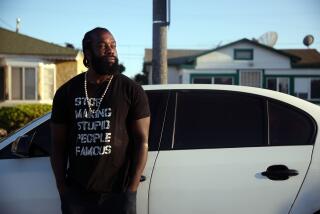Seeking a road to peace
It was big news when prosecutors filed criminal charges against a motorist who allegedly slammed on his brakes in front of two experienced cyclists July 4 on Mandeville Canyon Road, sending both to the hospital with serious injuries.
What didn’t make headlines was another Mandeville Canyon incident that day. Resident Lisa Block was finishing a morning walk on the narrow, winding road when she realized a clump of cyclists were coming up the hill straight at her.
“A guy heading right for me couldn’t move over because there were at least two other bikers to his left,” Block said. “I had to dive off the street and jump into the bushes.”
Though the cyclists were not acting maliciously, she said, the experience rattled her.
These days, many Angelenos are rattled as more cyclists hit the streets to combat high fuel prices, stay fit or help the environment. Riders on two wheels say drivers run them off the road, threaten bodily harm and unleash expletives, if not fists. Motorists counter that cyclists rip off car mirrors, zoom through stop signs and hurl expletives of their own -- often drenched in spit.
With the city of Los Angeles in the early stages of formulating a bike plan, and with motorist-vs.-cyclist road rage on the rise, politicians, engineers, residents and cycling enthusiasts have begun what all agree is a long-overdue conversation about how best to coexist on the city’s highways and byways.
“It’s a citywide issue of people sharing the road, whether on foot, a bicycle, a Vespa or in our cars,” said Jeanne Field, a Mandeville Canyon resident. “Manners have just gone out the window.”
Sprawling, smoggy and gridlocked, car-centric Los Angeles hardly pops to mind as a locale where cycling would thrive. But Bicycling magazine recently lauded the nation’s second-largest city as “a future best city” for biking.
The city has hired Alta Planning and Design, a transportation planning consultant based in San Rafael, Calif., to update its outmoded bicycle plan and attempt to create a safe, cohesive network from its more than 350 miles of bike routes, lanes and paths. Another goal is to identify a list of on-street bikeways, bike parking facilities and education programs that the city could develop over the next two decades.
“Los Angeles is a very challenging environment to ride in, given the condition of roadways, the storm grates that will eat your wheels, the lack of formal bike lanes or bike paths, and just a lack of respect and a lack of awareness from motorists about the rights of bicyclists,” said Matt Benjamin, an Alta transportation planner who says he bicycles “everywhere.”
--
More bicyclists
Reliable data on bicycle ridership in Los Angeles don’t exist, but signs of an uptick abound. Bicycle manufacturers and shops say they have seen spikes in business in recent months, and cycling advocacy groups say more riders have taken to the road. Demand has soared for the Los Angeles County Bicycle Coalition’s Metro bike lockers, which rent for $25 a year at many Metro Rail and Metro Orange Line stations, said Jennifer Klausner, the coalition’s executive director.
Spurred on by riders outraged by the Mandeville Canyon incident, Councilman Bill Rosendahl on July 11 introduced a Cyclists’ Bill of Rights to the City Council. The council unanimously supported the motion, which now heads to the transportation committee. Prepared by the Bike Writers Collective, an amalgam of enthusiasts and cycling bloggers, the bill of rights asserts that cyclists are the “indicator species” of a healthy community, represent solutions for environmental woes and traffic congestion, and have the right “to travel safely and free of fear” on public streets.
Separately, the bicycle coalition has proposed a pilot “share the road” program for Councilman Eric Garcetti’s district, which includes Hollywood, East Hollywood, Los Feliz, Silver Lake, Echo Park and Glassell Park. A key element would be “sharrows,” pavement markings that look like two chevrons with a bicycle. They would alert drivers that bicycles might be sharing the lane and show cyclists where they should place themselves -- toward the center of the lane -- to avoid being “doored” by an oblivious driver in a parked car. Garcetti’s office said Vermont and Fountain avenues are likely locations.
It might surprise some stressed-out, multitasking drivers to learn that the California Vehicle Code gives bicyclists more or less the same rights and rules as drivers of vehicles. Among other provisions, the code states that cyclists moving slower than the normal speed of traffic should ride as close as possible to the right-hand curb or edge of a roadway, but there are exceptions: When overtaking and passing another bicycle or vehicle heading in the same direction, when preparing for a left turn at an intersection or when necessary to avoid hazards, objects, vehicles or pedestrians.
After the uproar over the July 4 incident, Rosendahl first planned a town hall meeting to discuss the matter. With tensions escalating, he instead assembled, last Monday evening, an invitation-only task force of cyclists, residents and transportation officials to explore how best to ease the conflicts.
Although much of the discussion centered on Mandeville Canyon, “I do think the aggression that motorists are showing toward cyclists is common all over town,” said Klausner of the county bicycle coalition.
“We are the illegitimate bastard child of the transportation industry,” said Brad House, a member of the Los Angeles Bicycle Advisory Committee, who said he spoke only for himself. “Nobody wants us. In Europe, motorists are very respectful of cyclists. In this country, they want us off the road.”
He said he learned that firsthand when a driver pulled up behind him one day. House was in the center of a lane, intending to go straight.
“He yelled, ‘Get off the road or I’m going to hit you!’ ” House said. When the light turned green, House said, he pedaled forward and the driver “full-throttled his car into my bike,” totaling it. House said a highway patrolman wrote up the incident as an accident.
--
Sense of vulnerability
One longtime Mandeville resident said motorists’ hostility grows out of “the rudeness of the extreme faction” of cyclists. “The extreme ones have a very entitled-seeming way they carry themselves on the bike,” said Desmond McDonald, a mountain biker whose wife’s car mirror was recently broken off by an angry road cyclist. “This is arrogance coupled with . . . some sort of assault, whether hitting of the car physically, spitting on a woman’s car or calling her [a name].”
Many veteran riders acknowledge that cyclists occasionally break traffic rules or engage in name-calling when drivers yell, honk impatiently or come close to sideswiping them, but they contend that they react out of a sense of vulnerability.
Bruce J. Steele, an attorney who lives in Redondo Beach, confessed to having occasionally sworn at impatient or careless drivers, but added that “I try not to because we’re not going to win against a car.” Earlier this year, one of Steele’s friends was riding down an access road from the top of Palos Verdes Drive into a park. The 63-year-old man slammed head-on into an approaching maintenance truck that was obscured by heavy foliage. The resulting spinal cord injury paralyzed him from the waist down. He later suffered a stroke and died.
Easing the tension will require a number of steps.
“One certainly is education,” Steele said. “We need to understand we have to use public streets responsibly, but together.”
--
More to Read
Sign up for Essential California
The most important California stories and recommendations in your inbox every morning.
You may occasionally receive promotional content from the Los Angeles Times.










